1997 GMC SIERRA manual transmission
[x] Cancel search: manual transmissionPage 103 of 436

0 Move the lever up as far as it will go.
3. If you have four-wheel drive, be sure the transfer
case is in a drive gear
-- not in NEUTRAL (N).
4. Turn the ignition key to LOCK.
5. Remove the key and take it with you. If you can
leave your vehicle with the ignition key in your
hand, your vehicle
is in PARK (P).
Leaving Your Vehicle With the Engine
Running (Automatic Transmission
Models Only)
It can be dangerous to leave your vehicle with
the engine running. Your vehicle could move
suddenly if the shift lever is not fully in PARK (P)
with the parking brake firmly set.
If you have
four-wheel drive with
a manual transfer case
shift lever and your transfer case is in
NEUTRAL
(N), your vehicle will be free to roll,
even if your shift lever is in PARK
(P). So be sure
the transfer case is in
a drive gear -- not in
NEUTRAL
(N). And, if you leave the vehicle with
the engine running, it could overheat and even
catch fire.
You or others could be injured. Don’t
leave your vehicle with the engine running unless
you have
to.
ProCarManuals.com
Page 104 of 436
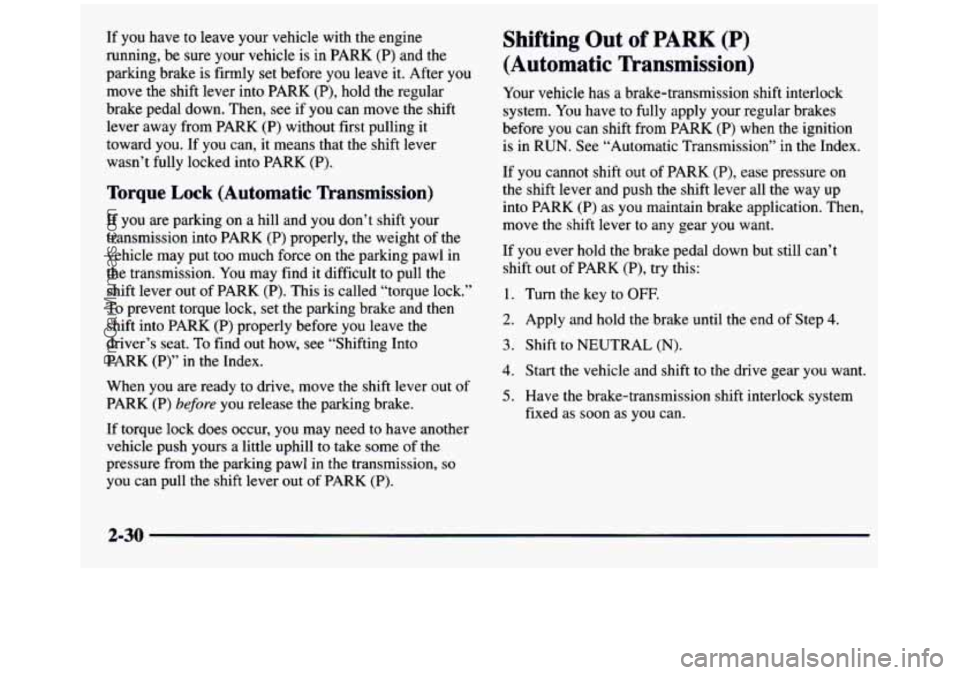
If you have to leave your vehicle with the engine
running, be sure your vehicle is in PARK (P) and the
parking brake is firmly set before you leave
it. After you
move the shift lever into PARK (P), hold the regular
brake pedal down. Then,
see if you can move the shift
lever away from PARK (P) without first pulling it
toward
you. If you can, it means that the shift lever
wasn’t fully locked into PARK
(P).
Torque Lock (Automatic Transmission)
If you are parking on a hill and you don’t shift your
transmission into PARK (P) properly, the weight of the
vehicle may put
too much force on the parking pawl in
the transmission. You may find
it difficult to pull the
shift lever out of PARK (P). This is called “torque lock.”
To prevent torque lock, set the parking brake and then
shift into PARK (P) properly before you leave the
driver’s seat.
To find out how, see “Shifting Into
PARK (P)” in the Index.
When you are ready
to drive, move the shift lever out of
PARK (P)
before you release the parking brake.
If torque lock does occur, you may need to have another
vehicle push yours a little uphill
to take some of the
pressure from the parking pawl in the transmission,
so
you can pull the shift lever out of PARK (P).
Shifting Out of PARK (P)
(Automatic Transmission)
Your vehicle has a brake-transmission shift interlock
system. You have
to fully apply your regular brakes
before you can shift from PARK (P) when the ignition
is in RUN. See “Automatic Transmission” in the Index.
If you cannot shift out of PARK (P), ease pressure on
the shift lever and push the shift lever all the way up
into PARK (P) as you maintain brake application. Then,
move the shift lever to any gear you want.
If you ever hold the brake pedal down but still can’t
shift out
of PARK (P), try this:
1. Turn the key to OFF,
2. Apply and hold the brake until the end of Step 4.
3. Shift to NEUTRAL (N).
4. Start the vehicle and shift to the drive gear you want.
5. Have the brake-transmission shift interlock system
fixed as soon as you can.
2-30
ProCarManuals.com
Page 105 of 436
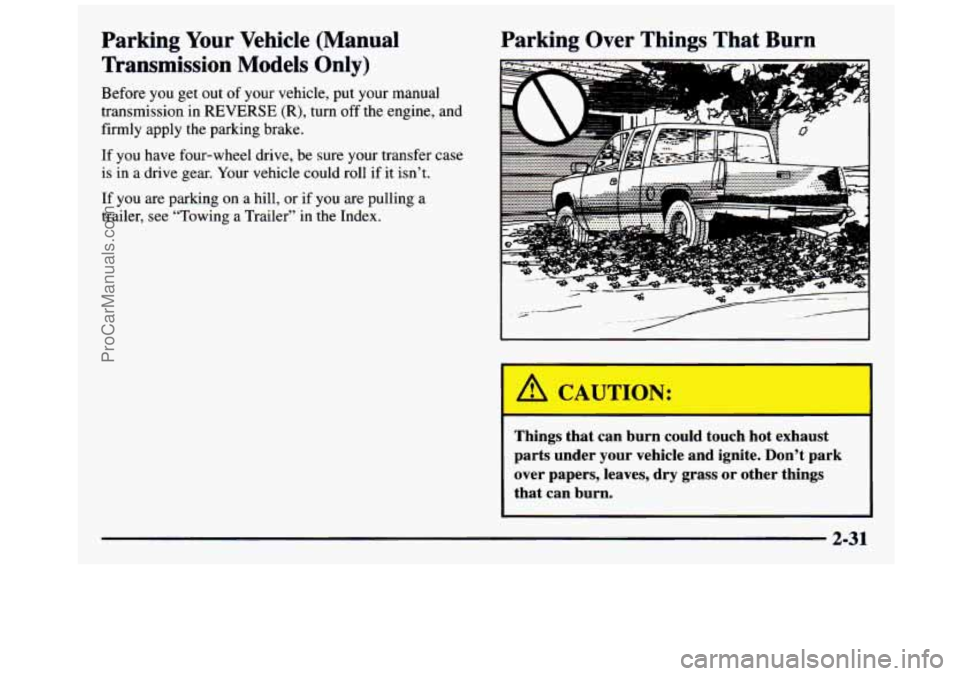
Parking Your Vehicle (Manual
Transmission Models Only)
Before you get out of your vehicle, put your manual
transmission
in REVERSE (R), turn off the engine, and
firmly apply the parking brake.
If you have four-wheel drive, be sure your transfer case
is in a drive gear. Your vehicle could roll
if it isn’t.
If you are parking
on a hill, or if you are pulling a
trailer, see “Towing a Trailer” in the Index.
Parking Over Things That Burn
I
2-31
ProCarManuals.com
Page 106 of 436
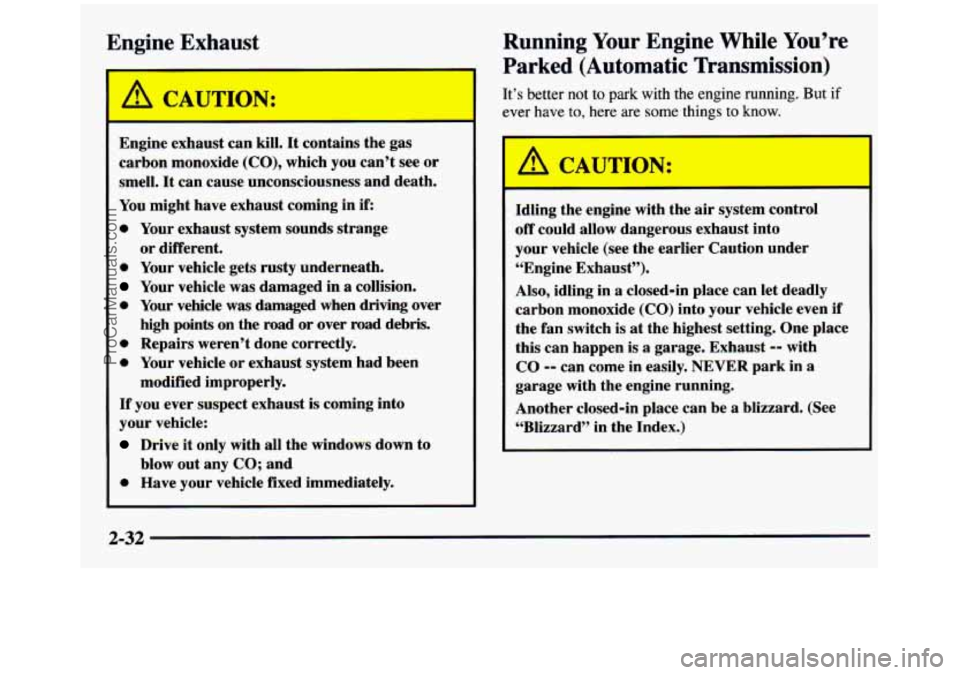
Engine Exhaust
Engine exhaust can kill. It contains the gas
carbon monoxide
(CO), which you can’t see or
smell.
It can cause unconsciousness and death.
You might have exhaust coming in if:
0 Your exhaust system sounds strange
0 Your vehicle gets rusty underneath.
Your vehicle was damaged in a collision.
0 Your vehicle was damaged when driving over
high points on the road or over road debris.
0 Repairs weren’t done correctly.
0 Your vehicle or exhaust system had been
If you ever suspect exhaust is coming into
your vehicle:
Drive it only with all the windows down to
0 Have your vehicle fixed immediately,
or
different.
modified improperly.
blow out any
CO; and
Running Your Engine While You’re
Parked (Automatic Transmission)
It’s better not to park with the engine running. But if
ever have
to, here are some things to know.
I
Idling the engine with the air system control
off could allow dangerous exhaust into
your vehicle (see the earlier Caution under
‘(Engine Exhaust”).
Also, idling in a closed-in place can let deadly
carbon monoxide
(CO) into your vehicle even if
the fan switch is at the highest setting. One place
this can happen
is a garage. Exhaust -- with
CO -- can come in easily. NEVER park in a
garage with the engine running.
Another closed-in place can be a blizzard. (See
“Blizzard” in the Index.)
2-32
ProCarManuals.com
Page 139 of 436
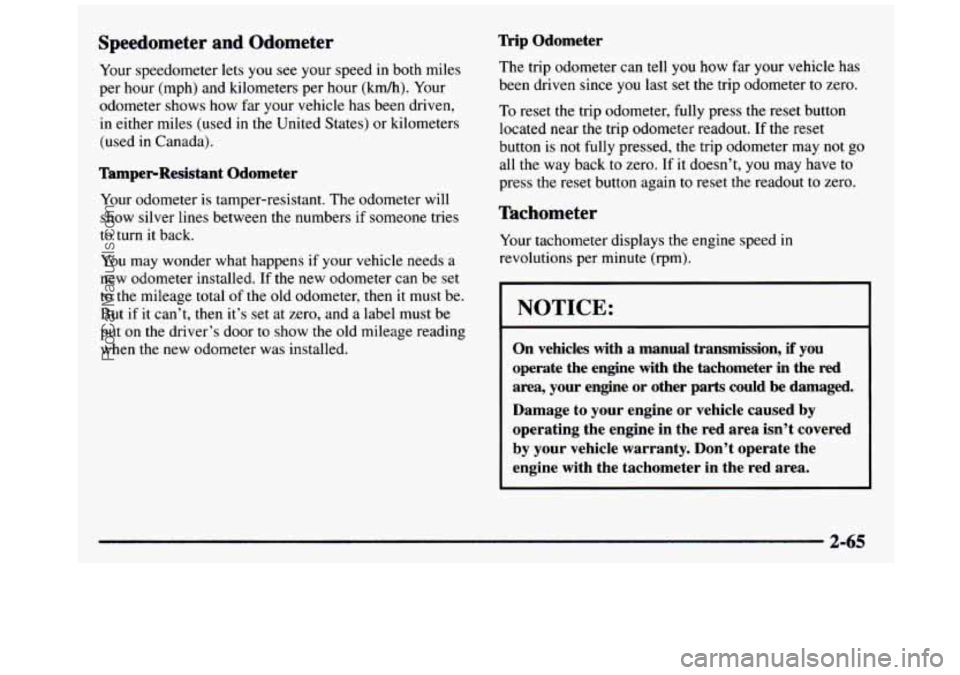
Speedometer and Odometer
Your speedometer lets you see your speed in both miles
per hour (mph) and kilometers per hour (km/h). Your
odometer shows how far your vehicle has been driven,
in either miles (used in the United States) or kilometers
(used
in Canada).
TamperResistant Odometer
Your odometer is tamper-resistant. The odometer will
show silver lines between the numbers
if someone tries
to turn
it back.
You may wonder what happens if your vehicle needs a
new odometer installed. If the new odometer can be set
to the mileage total of the old odometer, then
it must be.
But
if it can’t, then it’s set at zero, and a label must be
put
on the driver’s door to show the old mileage reading
when the new odometer was installed.
Wip Odometer
The trip odometer can tell you how far your vehicle has
been driven since
you last set the trip odometer to zero.
To reset the trip odometer, fully press the reset button
located near the trip odometer readout. If the reset
button is not fully pressed, the trip odometer may not go
all the way back to zero. If it doesn’t, you may have to
press the reset button again to reset the readout to zero.
Tachometer
Your tachometer displays the engine speed in
revolutions per minute
(rpm).
I NOTICE:
On vehicles with a manual transmission, if you
operate the engine with the tachometer in the
red
area, your engine or other parts could be damaged.
Damage
to your engine or vehicle caused by
operating the engine in the red area isn’t covered
by your vehicle warranty. Don’t operate the
engine with the tachometer in the red area.
2-65
ProCarManuals.com
Page 150 of 436
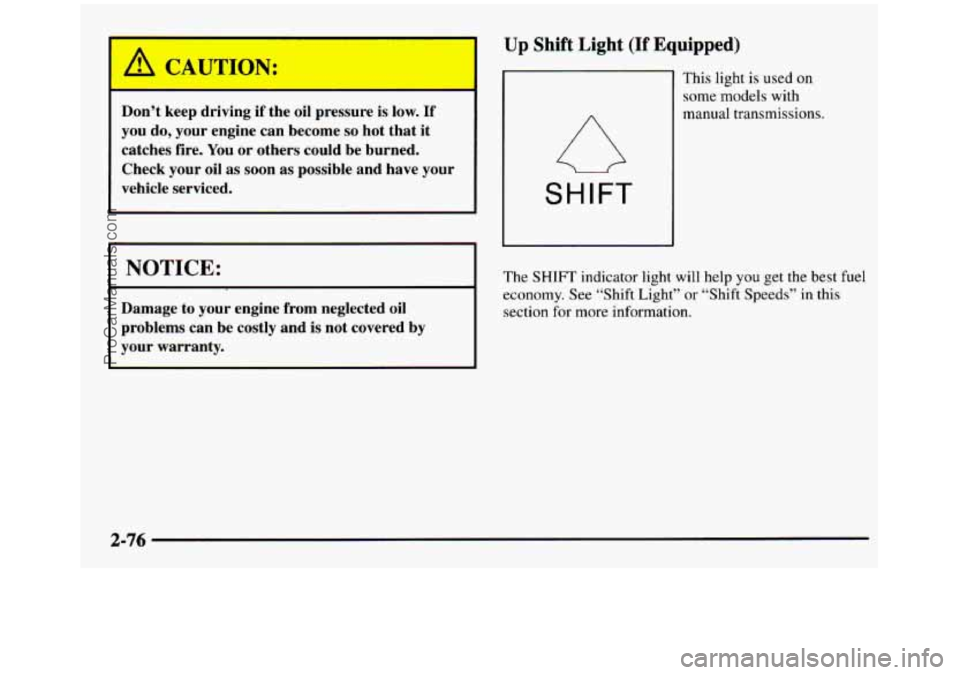
I !!i GL1U ION:
Don’t keep driving if the oil pressure is low. If
you do, your engine can become so hot that it
catches fire.
You or others could be burned.
Check your
oil as soon as possible and have your
vehicle serviced.
I NOTICE:
Damage to your engine from neglected oil
problems can be costly and is not covered by
your warranty.
Up Shift Light (If Equipped)
This light is used on
some models with
manual transmissions,
SHIFT
The SHIFT’ indicator light will help you get the best fuel
economy. See “Shift Light”
or “Shift Speeds” in this
section for more information.
2-76
.. .
ProCarManuals.com
Page 198 of 436
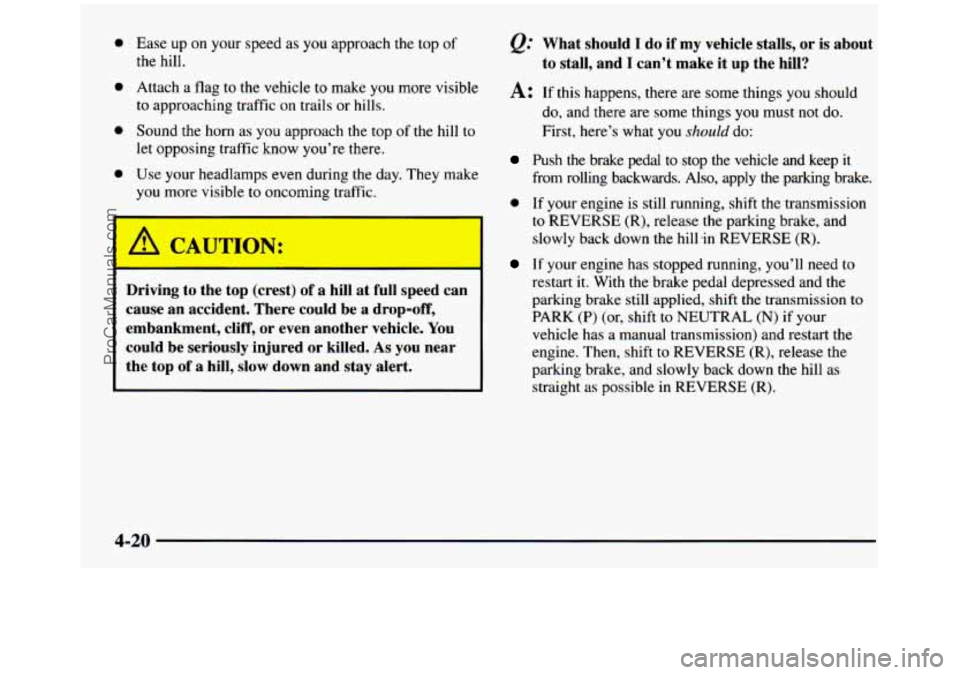
0
0
0
0
Ease up on your speed as you approach the top of
the hill.
Attach a flag
to the vehicle to make you more visible
to approaching traffic on trails or hills.
Sound the horn as you approach the top of
the hill to
let opposing traffic know you’re there.
Use your headlamps even during the day. They make
you more visible
to oncoming traffic.
J
Driving to the top (crest) of a hill at full speed can
cause an accident. There could be a drop-off,
embankment,
cliff, or even another vehicle. You
could be seriously injured or killed.
As you near
the top
of a hill, slow down and stay alert.
@ What should I do if my vehicle stalls, or is about
A: If this happens, there are some things you should
to stall, and I can’t make it up the hill?
do, and there are some things you must not do.
First, here’s what you
should do:
Push the brake pedal to stop the vehicle and keep it
from rolling backwards. Also, apply
the parking brake.
0 If your engine is still running, shift the transmission
to REVERSE
(R), release the parking brake, and
slowly back down the
hill in REVERSE (R).
If your engine has stopped running, you’ll need to
restart it.
With the brake pedal depressed and the
parking brake still applied, shift the transmission
to
PARK (P) (or, shift to NEUTRAL (N) if your
vehicle has a manual transmission) and restart
the
engine. Then, shift to REVERSE (R), release the
parking brake,
and slowly back down the hill as
straight as possible in REVERSE
(R).
4-20
ProCarManuals.com
Page 199 of 436
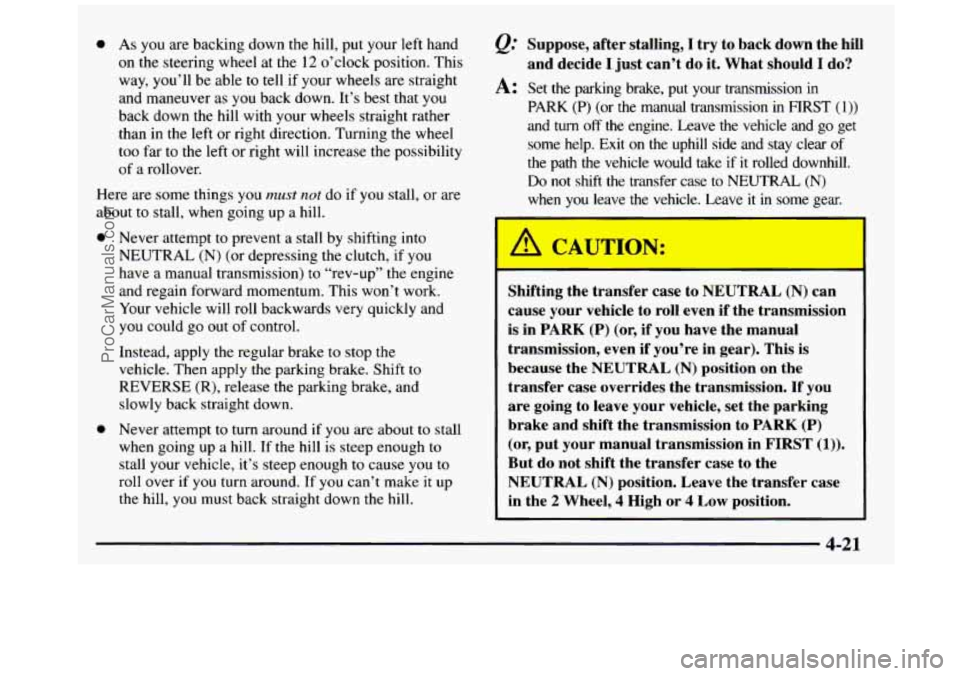
0 As you are backing down the hill, put your left hand
on the steering wheel at the 12 o’clock position. This
way, you’ll be able to
tell if your wheels are straight
and maneuver as you back down. It’s best that you
back down the
hill with your wheels straight rather
than
in the left or right direction. Turning the wheel
too far to the left or right will increase the possibility
of a rollover.
Here are some things you
must not do if you stall, or are
about to stall, when going up a hill.
0 Never attempt to prevent a stall by shifting into
NEUTRAL
(N) (or depressing the clutch, if you
have a manual transmission) to “rev-up” the engine
and regain forward momentum. This won’t work.
Your vehicle will roll backwards very quickly and
you could
go out of control.
Instead, apply the regular brake to stop the
vehicle. Then apply
the parking brake. Shift to
REVERSE (R), release the parking brake, and
slowly back straight down.
0 Never attempt to turn around if you are about to stall
when going up a hill. If the hill is steep enough
to
stall your vehicle, it’s steep enough to cause you to
roll over if you turn around.
If you can’t make it up
the hill, you must back straight down the hill.
@ Suppose, after stalling, I try to back down the hill
and decide
I just can’t do it. What should I do?
A: Set the parking brake, put your transmission in
PARK (P) (or the manual transmission in FIRST (1))
and turn off the engine. Leave the vehicle and go get
some help. Exit on the uphill side and stay clear
of
the path the vehicle would take if it rolled downhill.
Do not shift the transfer case to NEUTRAL (N)
when you leave the vehicle. Leave it in I ne gel
Shifting the transfer case to NEUTR
I (N) can
cause your vehicle to roll even if the transmission
is in PARK (P) (or, if you have the manual
transmission, even if you’re in gear). This is
because the
NEUTRAL (N) position on the
transfer case overrides the transmission.
If you
are going to leave your vehicle, set the parking
brake and shift the transmission to
PARK (P)
(or, put your manual transmission in FIRST (1)).
But do not shift the transfer case to the
NEUTRAL
(N) position. Leave the transfer case
in the
2 Wheel, 4 High or 4 Low position.
4-21
ProCarManuals.com